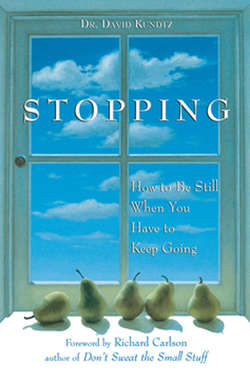Читать книгу Stopping - David Kundtz - Страница 22
На сайте Литреса книга снята с продажи.
Оглавление“I don't need to know how to breathe,”you're probably thinking. “I've been doing it sincethe day I was born—without a single lesson.”
IAN JACKSON
14
Breathing Is Inspiring
I'll never forget the moment I learned to breathe. No, it was not when the doctor slapped my bottom as a welcome into the world and I gulped my first intake of air. It was about forty-five years later when I was in training for certification as an interactive guided image therapist. During one of the sessions, we were led through a breathing exercise. The woman leading the group spoke slowly, calmly, and clearly about the process of breathing and how many of us breathe shallowly.
That teaching changed my life. I don't think anyone around me was aware of it (or were they being polite and discreet?), but as I breathed deeply in and then completely exhaled, involving the entire internal mechanisms of a diaphragmatic breath, I broke into an instant sweat because the experience was so new and overwhelming. As I continued to breathe consciously and fully, I then began to shake, because the experience was so physically and emotionally revolutionary. I know it seems odd now (I must have actually breathed deeply before that?!), but it felt like my first breath and like I had never really breathed deeply before. In the days and weeks that followed, I became a conscious breather, practicing frequently and learning the nuances of breathing.
Conscious breathing means to breathe deeply and intentionally. To breathe deeply is to begin the breath low in your belly and move it up into your chest.
To learn how to do this, begin by placing your left hand over your heart and your right hand over your belly button. As you breathe in, your right hand should move out and away from your body as your lungs fill with air, and your left hand should remain still. This movement should make you look “fatter” than you are; your stomach should be protruding. Then, as you breathe out, or exhale, your right hand should move back towards your body, and your left hand should remain still. The taking in of air moves your stomach, not your chest, out.
Too often what happens is that when we take in a deep breath, the left hand on the chest moves out, meaning that the air is kept shallow and high in the chest and does not bring oxygen to the lungs in an efficient way.
To take this a step farther to an even more complete breath, begin with your hands placed as above: left hand on your heart and right hand on your belly button. Breathe in and watch your right hand move out. But this time, continue to breathe in and when the right hand is out as far as is comfortable, bring the inhale up to your chest and allow the left hand to move out also. Then, as you breathe out, or exhale, the reverse movement happens as your left hand moves close to the body first and the right hand follows. As you do these breaths in succession, you will see that there is an undulating motion as air moves from down to up and from up to down: from the stomach to the chest and from the chest to the stomach.
